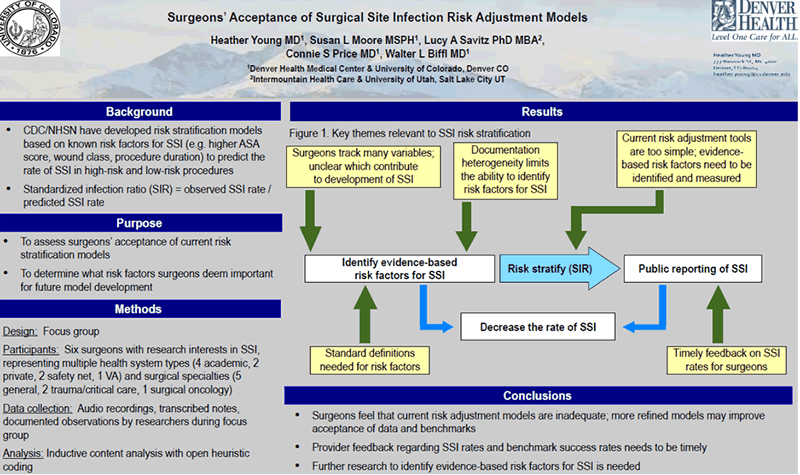Heather Young, MD1, Susan Moore, MSPH1, Lucy Savitz, PhD, MBA2, Connie S. Price, MD1 and Walter L. Biffl, MD1
(1) University of Colorado Health Sciences Center; Denver Health Medical Center, Denver, CO, (2) University of Utah; Intermountain Health Care, Salt Lake City, UT
Background: To account for the wide range of reported surgical site infection (SSI) rates, current CDC/NHSN risk stratification models were designed to predict the expected risk of SSI in different groups of patients. Surgeon acceptance of comparative data and risk adjustment is critical to drive quality improvement.
Objective: The purpose of this focus group was to assess surgeons' acceptance of current risk stratification models and to determine what factors surgeons felt are important for future models of SSI risk stratification.
Methods: Six academic surgeons with a research interest in SSIs, along with a facilitator, participated in a face-to-face focus group discussion held adjunct to the 5th Annual Academic Surgical Congress in San Antonio, TX. The surgeons represented multiple health system types, including academic (4), private (2), safety net (2), and veterans administration (1). Data were collected through audio recordings, transcribed notes, and observations by a qualitative researcher during the focus group session. Content analysis was conducted using an inductive approach with initial topics mentioned by participants identified through an open, heuristic coding process. Topics identified as duplicative were combined into a single occurrence. A topic was identified as a theme if at least 3 participants mentioned or agreed with a topic. Data were reviewed to the saturation point and discussed with the facilitator to ensure the most comprehensive identification of patterns.
Results: Multiple themes relevant to SSI risk stratification were identified and combined into 5 core concepts: (1) current risk adjustment models are inadequate; (2) surgeons acknowledged that they track an excessive number of variables that they feel contribute to SSI but emphasized the importance of focusing on factors that greatly affect the rate of SSI; (3) data are needed to determine which factors are most important and significant to the development of SSI, and risk stratification metrics must reflect this new data; (4) risks of SSI associated with emergency surgery should be considered separately from those of elective surgery; and (5) heterogeneous documentation (i.e., private vs public hospitals) affects the ability to both track and generalize the effects of potential risk factors on development of SSI.
Conclusions: Participating surgeons, representing multiple health system types, felt that the current models for SSI risk assessment are inadequate. While they believe that there are numerous factors that are likely important to accurately adjust risk, they agreed that many presumed risk factors may prove unimportant. A more refined risk adjustment model would likely improve surgeons' acceptance of benchmarks and comparative data, and it may also drive quality improvement. These data suggest that further efforts at risk factor assessment are worthwhile.
Figure 1: Poster presented at SHEA conference

Text Description
Authors: Heather Young, MD1, Susan Moore, MSPH1, Lucy Savitz, PhD, MBA2, Connie S. Price, MD1 Walter L. Biffl, MD1
1 Denver Health Medical Center & University of Colorado, Denver CO
2 Intermountain Health Care & University of Utah, Salt Lake City UT
Background: CDC/NHSN have developed risk stratification models based on known risk factors for SSI (e.g. higher ASA score, wound class, procedure duration) to predict the rate of SSI in high-risk and low-risk procedures. Standardized infection ratio (SIR) = observed SSI rate / predicted SSI rate.
Purpose: To assess surgeons acceptance of current risk stratification models. To determine what risk factors surgeons deem important for future model development.
Methods: Design: Focus group
Participants: Six surgeons with research interests in SSI, representing multiple health system types (4 academic, 2 private, 2 safety net, 1 VA) and surgical specialties (5 general, 2 trauma/critical care, 1 surgical oncology)
Data collection: Audio recordings, transcribed notes, documented observations by researchers during focus group
Analysis: Inductive content analysis with open heuristic coding
Results: A flowchart graphic (Figure 1) illustrates key themes relevant to SSI risk stratification, as follows: Surgeons track many variables; unclear which contribute to development of SSI, Documentation heterogeneity limits the ability to identify risk factors for SSI, and Standard definitions needed for risk factors were all shown as themes perceived to affect the identification of evidence-based risk factors for SSI. Current risk adjustment tools are too simple; evidence-based risk factors need to be identified and measured was shown as perceived to affect the risk stratification (SIR) process. Timely feedback on SSI rates for surgeons was shown as perceived to affect public reporting of SSI. Public reporting of SSI and identification of evidence-based risk factors for SSI were shown as contributing to decrease the rate of SSI.
Conclusions: Surgeons feel that current risk adjustment models are inadequate; more refined models may improve acceptance of data and benchmarks. Provider feedback regarding SSI rates and benchmark success rates needs to be timely. Further research to identify evidence-based risk factors for SSI is needed.



